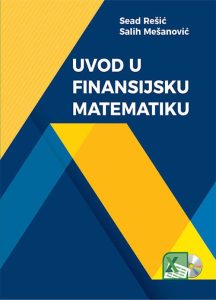PREFACE
The book »Introduction to Financial Mathematics«, based on the volume, complexity, topicality and innovativeness of the content, has the characteristics of a university textbook intended for undergraduate and postgraduate students of economics colleges and other related colleges and universities, who have programs in Financial Mathematics. The textbook can be used by students of Mathematics faculties for the Applied Mathematics major, which have contents of financial mathematics in their curriculums. The book is the result of the authors’ scientific and research work and can be used by teachers and researchers in the field of financial mathematics.

The textbook has two chapters. The first chapter is Interest Account with two units: Simple and Compound Interest Account with Applications. Chapter Two is Loan Repayment, with units: General Concepts on Loans; Loans with Equal, Decursive Annuities; Loans with Rounded, Equal, Decursive Annuities and Annuity Residue; Loans with Equal, Decursive Repayments; Loans which Decursive Repayments are Members of the Geometric Sequence; Loans Divided into Bonds; Repayment of Loans Using an Anticipated Interest Rate; Conversion and Consolidation of Loans and Intercalary interest. Under the Loan Conversion and Consolidation chapter, medium-term and joint-term deferred payment accounts were introduced using a conforming interest rate. One irregular medium-term account of deferred payments, which is present in the used literature and practice, is highlighted.
Based on the research and the literature used, the authors of the textbook have innovated preceding simple and compound interest account with some of their adequate applications.
In the application of the interest account, and especially in loans, some new relations between the values of economic and financial mathematics have been introduced, based on the current economic and mathematical theory and practice. Within the theoretical, methodological and applied considerations of the relations between the investigated values, the following methods were used: analysis and synthesis, induction and deduction, comparison and modeling.
In introducing new relations between the values that were the subject of the research, among other things, two basic methods of research in economic and financial mathematics were used:
(1) the discounting method (reducing the amount of a present value to the equivalent amount of a past value), and
(2) the compounding method (reducing the amount of a present value to the equivalent amount of a future value).
The authors of the textbook have critically pointed out the observed irregular relations between the values of the interest formula and its application and some irregular applications of interest, ie interest rates and factors, with evidence of their irregularity. The disputable application of the effective interest rate for loans and deposits that has no regular equation for calculating in theory, practice and law, has been pointed out. A regular equation has been introduced to calculate the effective interest rate in relation to the nominal interest rate, the loan amount, its repayment term and the recorded discounted costs for the loan repayment or deposit payment term.
Of particular importance is the proof of irregularity of the function (formula) for continuous capitalization, with irregular application, found in the literature and practice to date.
In the examples, the necessary calculations were made using small engineering computers (calculators), whose precision was calculated with a maximum of ten correct digits. The monetary amounts were rounded to 3 decimal places, with the accuracy of presented calculated amounts being increased 10 times.
Some notable examples have been done in Excel 2010, based on the introduced equations (functions) and Excel functions and spreadsheets, which are contained on the CD enclosed with the textbook. You can also download the examples in Excel at the following link.
You can get the textbook here.
